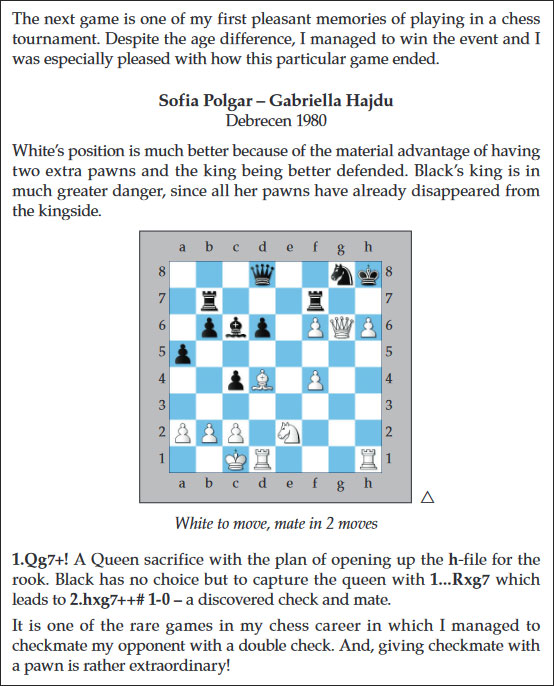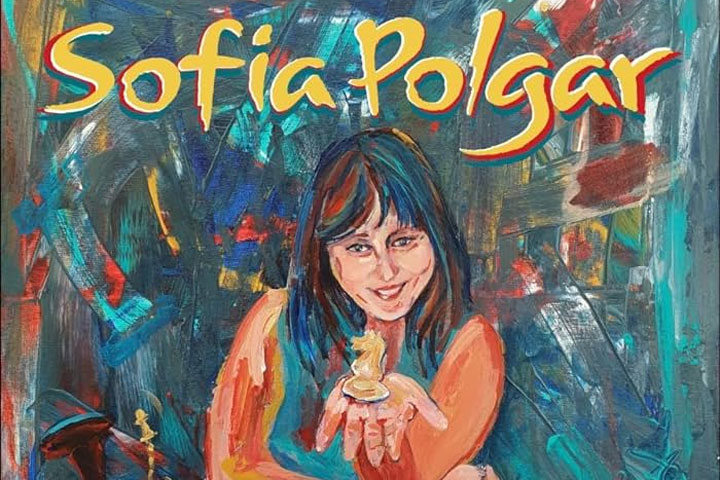Foreword by Susan Polgar
Sofia has been – somewhat unfairly – in the shadow of her sisters, but she has accomplished a great deal in chess in her own right. In addition to being a multiple-time Olympic champion, she is most famous for winning a major international tournament in Rome with an amazing score of 8½ points out of 9, ahead of a number of Soviet grandmasters. That unbelievable score meant a performance rating of 2930 (a world record at any open tournament in those days), which gave her front-page coverage in many chess magazines. Read more about it the chapter “Miracle in Rome.”
In her book, Sofia introduces the reader to the basics of chess in a fun and entertaining way. She gives you an insight into the world of chess from her childhood memories through the years of being a professional chessplayer. She has always been known for her fearless attacking style of play and countless combinations, dangerous even for grandmasters. In her book the most important (and beautiful) chess tactical motifs are illustrated by her own artwork, along with fun quotes taken from the greats of chess to mainstream celebrities.
I remember that Sofia, even as a young girl (7-8 years old), used to love arts and would draw beautiful colorful drawings effortlessly, sometimes even during chess training. After her retirement from competitive chess, she prioritized taking care of her family, while at the same time art (and specifically painting and drawing) became her passion. In this work, she explains the parallels between art in general and art in chess. It is on one hand a fun instructional chess book, and on the other hand, a journey for the reader, learning about Sofia and her family. You are invited to enjoy the experience of the wonderful legacy of Sofia’s amazing chess career and art.
Judit Polgar
My sister Sofia is a wonderful person. A treasure. She has been an honest and true friend from the day I was born to this day. I like to think that will always be the case. I remember the atmosphere of our training sessions, and how much we giggled, smiled, and laughed. We were together in good times and hard times. It is always a pleasure and fun to talk and work with her, as we did at the first educational chess book, followed by more later. Her passion as a teacher-educator, her positivity, and her open, creative attitude and vision are contagious, all of which come through while reading this book, thanks to her unique writing style.
I wish the readers a pleasant journey on this artistic excursion that provides great chess lessons while also offering nourishment for the soul. Enjoy!

The Polgar family in the 1980: Zsuzsa, Judit and Sofia, with mother Klara and father Lazlo. Behind them the "Kartotek", the index card register boxes which the parents installed. It contained thousands of well classified games – no ChessBase at the time!
Sofia was born in Budapest in In 1974. "It was a very different world," she writes, "with Russian troops still in Hungary. When I first opened my eyes, it was behind the Iron Curtain of a Communist regime." Both parents, mother Klara and father Laszlo, were teachers and embarked on a unique “experiment” in child education, both earned PhDs on the subject.
Sofia's Introduction
My collection of chess games and visual art was selected with the purpose of passing on my love for the game, showing its aesthetic side with easy-to-understand explanations and inspiring players of all ages to think creatively. It is also my way of reaching out to people who like paintings and inviting them to appreciate the world of chess.
Chess is a lot like music: it can be enjoyed on so many different levels. When you start understanding the patterns and play the tunes – and in the case of chess, the moves – you acquire a new perspective about appreciating its inherent harmony. I had already started learning the tactical patterns by age four. In one way or another, chess has been a part of my life since then.
After a competitive chess career that spanned more than twenty years, I have spent years teaching club players. I have given private lessons, taught small groups and also larger classrooms in schools. As I reviewed material for inclusion in this book, I realized how the same patterns are repeated over and over on various levels. I came to the conclusion that the best way to pass on knowledge of tactics through my games is by teaching these chess themes. There is no doubt that you will encounter the topics covered in the upcoming chapters in your own games.
Learn and enjoy! Or even better: Enjoy and learn!
Basic chess lessons
The book starts pretty much from scratch: it teaches the moves, basic openings and tactics. Interwoven are enchanting stories from early childhood, like her first tournaments, at the age of five, competing in the Under-11 Hungarian Girls’ Championship. There one of the boys, rocking back and forth on his chair, fell off. "Of course, my five year-old self had to see what was going on and my eyes turned to the 'action' in the playing hall rather than keeping them on the chessboard. That led to a blunder and little Sofia succumbed to a mate in one. "Now I was the one who almost fell off the chair..."
A year later she was able to deliver a very nice mate herself. This is what the narrative looks like in the book:

There follow lessons on basic tactics: forks, needles and pins, discovered attacks, all illustrated with positions from her games, with little stories around them. What I enjoyed doing is to cover up the text after a diagram and try and see the tactical shot myself. You can try it on these two positions:
These are fun spot-the-win positions. The book is full of equally entertaining games, which are instructively annotated and a pleasure to replay. I asked Sofia to select her two favourites, which she found difficult: "It is like asking me which is my favourite son. If I have to pick only two games, they would both from 1994 [when she was 19!]: S. Kerma and G. Vescovi. The latter is perhaps a bit too complicated, but professionally I'm most proud of that U20 championship after Rome.
Part two of this review, with pictures and paintings, will follow shortly.
Sofia's book makes for a wonderful Christmas present, one you will enjoy for months to follow.

Contents
1 Introduction
2 Family Background
3 Basic Chess Lessons
4 Watch Your Back!
5 Sicilian Madness and Youth Championships
6 King’s Gambit
7 Attack on the Seventh Rank
8 Olympic Experience
9 Open Files and Diagonals
10 Going After the King
11 Miracle in Rome
12 Chess and Friends
You can get it from Amazon, and from chess dealers worldwide. If you want something really special, you can order it from Schach Niggemann, who has a limited number of luxury hard cover copies signed by Sofia.


























